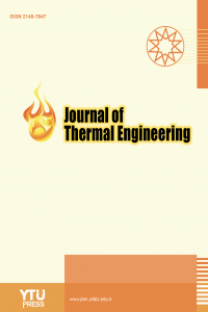A CFD investigation of the design variables affecting the performance of finned-tube heat exchangers
A CFD investigation of the design variables affecting the performance of finned-tube heat exchangers
CFD, Heat Exchanger, Fin Tube, Coil, Thermofluid, Heat Transfer,
___
- REFERENCES
- [1] Rohsenow WM, Hartnett JP, Cho YI. Handbook of Heat Transfer. New York: McGraw-Hill; 1998. [2] Dixit T, Al-Hajri E, Paul MC, Nithiarasu P, Kumar S. High Performance, Microarchitected, Compact Heat Exchanger Enabled by 3D Printing Appl Therm Eng 2022;210:118339. [CrossRef] [3] Bergman TL, Bergman TL, Incropera FP, Dewitt DP, Lavine AS. Fundamentals of Heat and Mass Transfer. New Jersy: John Wiley & Sons; 2011. [4] Thulukkanam, K. Heat Exchanger Design Handbook. Boca Raton: CRC Press; 2000. [CrossRef] [5] Hewitt GF, Shires GL, Bott T. Process Heat Transfer. New York: Begell House; 1994. [6] Oguntala G, Sobamowo G, Abd‐Alhameed R. Effects of particle fouling and magnetic field on porous fin for improved cooling of consumer electronics. Heat Transfer 2020;49:779–799. [CrossRef] [7] Doğan B, Ozturk MM, Erbay LB. Numerical investigation of heat transfer and pressure drop characteristics in an offset strip fin heat exchanger. J Therm Eng 2021;7:1417–1431. [CrossRef] [8] Shkarah A. Convective heat transfer and fully developed flow for circular tube newtonian and non-newtonian fluids condition. J Therm Eng 2021;7:409–414. [CrossRef] [9] Patil PS, Dhande KK, Borse SL. Experimental investigation of heat transfer and pressure drop using combination of ribs and dimples. Aust J Mech Eng 2021;21:628641. [CrossRef] [10] Mohamed SA, Karimi MN. Analysis and optimization of vapor absorption generator-heat exchanger using kern method and CFD. J Therm Eng 2020;6:440–459. [CrossRef] [11] Rezende TR, Vianna RF, Luporini S. Simulation of a Plate Heat Exchanger Operating with Nanofluid Coolant Using CFD. Int J Heat Technol 2021;39:235–240. [CrossRef] [12] Amghar K. Numerical study of turbulent heat transfer in a horizontal channel provided with square blocks: effect of the inter blocks spacing. J Therm Eng 2021;7:650–665. [CrossRef] [13] Feroze T, Genc B. Estimating the effects of line brattice ventilation system variables in an empty heading in room and pillar mining using CFD. J South Afr Inst Min Metall 2016;116:1143–1152. [CrossRef] [14] Feroze T, Genc B. Analysis of the effect of ducted fan system variables on ventilation in an empty heading using CFD. J South Afr Inst Min Metall 2017;117:157–167. [CrossRef] [15] ANSYS. Ansys Fluent Theory Guide. Pennsylvania: Ansys Inc.; 2011;15317: 724–746. [16] Alfarawi, S. S. S., Azeldin El-sawi, and Hossin Omar. Exploring discontinuous meshing for CFD modelling of counter flow heat exchanger. J Adv Res Numer Heat Transf 2021;5:26–34. [17] Rocha DM, Kanizawa FT, Hayashi K, Hosokawa S, Tomiyama A, Ribatski G. Characterization of the velocity field external to a tube bundle using spatial filter velocimetry based on variable meshing scheme. Flow Turbul Combust 2020;105:1277–1301. [CrossRef] [18] Al-Faize MM, Jabar WM. The efficiency of number of tube passes of msf heat exchanger materials for water desalination. Mater Today Proceed 2022;49:2802–2805. [CrossRef] [19] Demianiuk A, Sorko SA. Analysis of flow and thermal phenomena in evacuated tube collectors. Acta Mech et Automat 2012;6:5–10. [20] Nasiruddin, Siddiqui MHK. Heat transfer augmentation in a heat exchanger tube using a baffle. Int J Heat Fluid Flow 2007;28:318–328. [CrossRef] [21] Kuruneru STW, Vafai K, Sauret E, Gu Y. Application of porous metal foam heat exchangers and the implications of particulate fouling for energy-intensive industries. Chem Eng Sci 2020;228:115968. [CrossRef] [22] Al-Zaidi, AH, Mahmoud MM, Karayiannis TG. Flow Boiling in Copper and Aluminium Microchannels. International J Heat Mass Transf 2022;194:123101. [CrossRef] [23] Senthilkumar P, Suyambazhahan S, Suresh PR, Velraj R. Enhancement of heat transfer performance in an aluminum heat sink using different nanocoatings. J Enhanc Heat Transf 2021;28:4161. [CrossRef] [24] Hanan A, Zahid U, Feroze T, Khan SZ. Analysis of the performance optimisation parameters of shell and tube heat exchanger using CFD. Aust J Mech Eng 2021;21:830843. [CrossRef] [25] Grzybowski, H., and Mosdorf, R. Modelling of pressure-drop instability in single and multi microchannels system. Acta Mech et Autom 2012;6:45–51. [26] Okbaz A, Pınarbaşı A, Olcay AB. Experimental investigation of effect of different tube row-numbers, fin pitches and operating conditions on thermal and hydraulic performances of louvered and wavy finned heat exchangers. Int J Therm Sci 2020;151:106256. [CrossRef]
- Yayın Aralığı: 6
- Başlangıç: 2015
- Yayıncı: YILDIZ TEKNİK ÜNİVERSİTESİ
Entropy generation of Al2O3/water nanofluid in corrugated channels
Samet ERKOL, Melih YÜCESAN, Muhammet GÜL, Ali Fuat GÜNERI
Freeze-drying kinetics and diffusion modeling of hawthorn
Khaled Ali HAGIG, Bahadır ACAR, Edip TAŞKESEN, Edip TAŞKESEN, Edip TAŞKESEN, Mehmet ÖZKAYMAK
Mohammed HASHEER SK, Srinivas KOLLA, Dasari KONDALA RAO, Yellapragada NAGA VENKATA SAI RAM
Davood SHAFIEI, Seyed Alireza MOSTAFAVI, Saeid Jafari MEHRABADI
Ebrahim BARATI, Mehdi Rafati ZARKAK, Shohreh JALALI
Sahin GUNGOR, Sinan GOCMEN, Erdal CETKIN
Vivek CHOPRA, Rajeev Kumar MISHRA, Vijay Kumar DWIVEDI, Baibaswata MOHAPATRA
